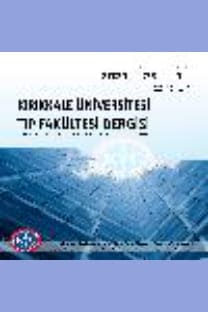HİSTOLOJİ ÖĞRENEN TIP VE DİŞ HEKİMLİĞİ FAKÜLTESİ ÖĞRENCİLERİNDE MOTİVASYON
Motivasyon, histoloji, sağlık bilimleri, eğitim
Motivation in Medicine and Dentistry Faculty Students Learning Histology
Motivation, histology, health sciences, education,
___
- Pintrich PR, Marx RW, Boyle RA. Beyond cold conceptual change: The role of motivational beliefs and classroom contextual factors in the process of conceptual change. Review of Educational Research. 1993;63(2):167-99.
- Kelecioğlu H. Güdülenme. Hacettepe Üniversitesi Eğitim Fakültesi Dergisi. 1992;7:175-181.
- Eccles JS, Wigfield A. Motivational beliefs, values, and goals. Annual review of psychology. 2002;53(1):109-32.
- Bryan RR, Glynn SM, Kittleson JM. Motivation, achievement, and advanced placement intent of high school students learning science. Science education. 2011;95(6):1049-63.
- Glynn SM, Brickman P, Armstrong N, Taasoobshirazi G. Science motivation questionnaire II: validation with science majors and nonscience majors. Journal of research in science teaching. 2011;48(10):1159-76.
- Campos-Sánchez A, López-Núñez JA, Carriel V, Martín-Piedra MÁ, Sola T, Alaminos M. Motivational component profiles in university students learning histology: a comparative study between genders and different health science curricula. BMC medical education. 2014;14(46):1-13.
- Osborne J, Simon S, Collins S. Attitudes towards science: a review of the literature and its implications. Int J Sci Educ. 2003;25(9):1049-79.
- Merk M, Knuechel R, Perez-Bouza A. Web-based virtual microscopy at the RWTH Aachen university: didactic concept, methods and analysis of acceptance by the students. Annals of Anatomy-Anatomischer Anzeiger. 2010;192(6):383-7.
- Tufts MA, Higgins-Opitz SB. What makes the learning of physiology in a PBL medical curriculum challenging? Student perceptions. Advances in physiology education. 2009;33(3):187-95.
- Sen S, Yılmaz A. Investigating high school and university students’ motivation towards chemistry: a cross age study. Western Anatolian Journal of Educational Science (WAJES). 2014;5(10):17-37.
- Kusurkar RA, Croiset G, Mann KV, Custers E, Ten Cate O. Have motivation theories guided the development and reform of medical education curricula? A review of the literature. Academic Medicine. 2012;87(6):735-43.
- Gallagher J, Clarke W, Wilson N. Understanding the motivation: a qualitative study of dental students’ choice of professional career. European Journal of Dental Education. 2008;12(2):89-98.
- Pajares F. Gender differences in mathematics self-efficacy beliefs. Cambridge University Press, 2005.
- Abdel Meguid EM, Smith CF, Meyer AJ. Examining the motivation of health profession students to study human anatomy. Anatomical Sciences Education. 2020;13(3):343-52.
- Kusurkar RA, Croiset G. Autonomy support for autonomous motivation in medical education. Medical education online. 2015;20(1):1-3.
- Simons J, Dewitte S, Lens W. The role of different types of instrumentality in motivation, study strategies, and performance: Know why you learn, so you’ll know what you learn! British Journal of Educational Psychology. 2004;74(3):343-60.
- Kusurkar RA. Autonomous motivation in medical education. Medical teacher. 2019;41(9):1083-1084.
- Deepak KK, Al-Umran KU, Al-Sheikh MH, Al-Rubaish A. The influence of gender on undergraduate performance in multiple choice testing in clinical disci-plines at University of Dammam, Saudi Arabia. Al Ameen J Med Sci. 2011;4(2):123-30.
- McDonough CM, Horgan A, Codd M, Casey P. Gender differences in the results of the final examination at University College Dublin. Medical Education-Oxford. 2000;34(1): 30-4.
- Kusurkar R, Kruitwagen EC, Ten Cate O, Croiset G. Effects of age, gender and educational background on strength of motivation for medical school. Advances in health sciences education. 2010;15(1):303-13.
- ISSN: 2148-9645
- Yayın Aralığı: 3
- Başlangıç: 1999
- Yayıncı: KIRIKKALE ÜNİVERSİTESİ KÜTÜPHANE VE DOKÜMANTASYON BAŞKANLIĞI
Romatoid Artritte Yeni Bir İnflamasyon Belirteci: İmmatür Granülosit
GEBELİKTE GEÇİRİLEN COVİD-19 ENFEKSİYONUNUN NEONATAL MORBİDİTELER VE MORTALİTE ÜZERİNE ETKİSİ
Ümit Ayşe TANDIRCIOĞLU, Özge DOĞAN, Pelin PELİT, Murat CAGAN, Sanem ÖZCAN, Özgür ÖZYÜNCÜ, Şule YİĞİT, Tolga ÇELİK
Monosemptomatik ve Monosemptomatik Olmayan Enürezis Arasındaki Klinik ve Laboratuvar Farklılıklar
Zeynep ARSLAN, Yaşar KANDUR, Ayşegül ALPCAN, Ümran KORAL, Serap YÖRÜBULUT
Çocuklarda COVİD-19 Şiddeti ile D Vitamini Arasındaki İlişki
Özlen BALTA, Firdevs AKSOY, Nurten Nur AYDIN, Medine Gözde ÜSTÜNDAĞ, Seçuk KAYA, Gürdal YILMAZ, İftihar KÖKSAL
Yenidoğanlarda Fototerapi Tedavisinin Oksidatif Stres ve İnflamatuar Yanıt Üzerine Etkisi
Gülşah AĞIRTAŞ, Nilufer GUZOGLU, Ozgül AKBAŞ, Üçler KISA, Didem ALİEFENDİOĞLU
Anna Carina ERGANİ, Meltem GÜMÜŞ, Muslu Kazım KÖREZ, Halil Haldun EMİROĞLU
YÜKSEK YOĞUNLUKLU LAZER TEDAVİSİNİN KAS İSKELET SİSTEMİ HASTALIKLARINDA KULLANIMI
Şahika Burcu KARACA, Fazilet AYAN
Vitamin D ve Omega 3’ün Vena Kava Üzerine Etkilerinin Araştırılması
Bahar KARTAL, Ebru ALİMOĞULLARI, Mehmet Fatih BOZKURT, Muhammad Nasir BHAYA, Hazal DEMİR, Uygar SAÇIK
